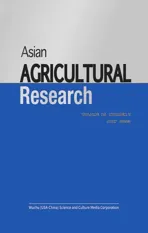Intellectual Property Protection and New Development Pattern Construction of Xinjiang Jujube
2023-08-02MiaomiaoXUYulanBAIJinjinWANGYuanpengSUNJinZENGZhiguoSUN
Miaomiao XU, Yulan BAI, Jinjin WANG, Yuanpeng SUN, Jin ZENG, Zhiguo SUN
1. Research Base for Forging the Sense of Community for the Chinese Nation, Hubei University of Science and Technology, Xianning 437100, China; 2. College of Economics, Xinjiang University of Science and Technology, Korla 841000, China
Abstract "Three new developments" is the guiding ideology of Chinese-style high-quality development in the new era. Jujube (Zizyphus jujube Mill.) is a plant of Zizyphus of Rhamnaceae, which originated in China and has been listed as one of the "five fruits" since ancient times. Xinjiang is the most important jujube producing area in China, and its yield has accounted for 50% of the national jujube yield. In the five prefectures and cities of southern Xinjiang, as well as the regimental farms of southern and eastern Xinjiang of Xinjiang Production and Construction Corps, the jujube industry is an advantageous characteristic industry in agriculture. This paper studied Xinjiang jujube industry and its agricultural intellectual property resources, analyzed six major issues to be further implemented, such as the "three new developments" thinking and the strategy of building an intellectual property power, and puts forward eight strategies such as coordinating the two markets and two resources to accelerate the construction of a new development pattern and dual circulation of jujube.
Key words Jujube (Zizyphus jujube Mill.), Fruit, Intellectual property, New development pattern, Xinjiang
1 Introduction
Jujube (ZizyphusjujubeMill.) is a plant ofZizyphusof Rhamnaceae. Growing below 1 700 m above sea level, the jujube is adaptable, drought-tolerant, barren-resistant, temperature-loving fruit trees, native to China, has been cultivated in China for more than 4 000 years, and has been listed as one of the "five fruits" (peaches, plums, prunes, apricots, jujubes) since ancient times, and are now cultivated in other parts of Asia, as well as in Europe and the Americas. Jujube is rich in protein, amino acids, sugars, organic acids, vitamin A, vitamin B2, vitamin C, vitamin P, as well as trace elements calcium, phosphorus, potassium, iron, magnesium, aluminum and a large amount of cyclic adenosine monophosphate. In addition to table fruit, it can often be made into candied dates, dried jujube, smoked dates, black dates, wine dates, tooth dates and other preserves and preserved fruits, and can also be used as jujube paste, jujube noodles, jujube wine, jujube vinegar,etc.as raw materials for the food industry. In terms of traditional Chinese medicine, jujube has the effects of strengthening the spleen and stomach, nourishing qi and blood, nourishing blood and calming the nerves, and easing medicinal properties.
Xinjiang, Hebei, Shandong, Shanxi, Shaanxi and Henan are the main jujube producing areas in China, accounting for more than 90% of the country’s total jujube yield. Xinjiang is a typical inland arid semi-desert, desert and extremely arid desert climate, with long sunshine time, large temperature difference between day and night, and irrigated agricultural environment, which is very suitable for the growth and development of jujube. With recent years of development, the yield of Xinjiang jujube has exceeded 50% of the national jujube. In the five prefectures and cities of southern Xinjiang and Xinjiang Production and Construction Corps and regimental farms in southern and eastern Xinjiang, jujube industry is an advantageous and characteristic agricultural industry[1], and is an important economic source for farmers, especially in the former deeply impoverished prefectures in the southern Xinjiang prefectures-Hotan Prefecture, Kashgar Prefecture, Aksu Prefecture and Kizilsu Kirghiz Prefecture. It is an important task of rural revitalization to prosper rural advantageous industries and promote high-quality development. TheStrategicPlanforRuralRevitalization(2018-2022) issued by the CPC Central Committee and the State Council requires that we should expand characteristic advantageous industries and cultivate, and enhance agricultural brands. From July 12 to 15, 2022, General Secretary XX emphasized during his inspection tour in Xinjiang that we should cultivate and expand Xinjiang’s characteristic advantageous industries.
Intellectual property is an important factor of production in the knowledge economy and a core element of international competitiveness[2-5]. TheOutlineforBuildinganIntellectualPropertyPower(2021-2035) issued by the Central Committee of the Communist Party of China and the State Council on September 23, 2021, deployed six key tasks to support the strategy of building an intellectual property power. The Outline requires that we should strengthen the construction of institutional systems and improve the level of protection, and propose to build a strong engine for high-quality development. Xi Jinping’s "three new developments" thinking[6-8]is to accurately grasp the new development stage, deeply implement the new development concept, and accelerate the construction of new development pattern, which is the guiding ideology of high-quality development of Chinese style in the new era.
In view of the above situation, we studied jujube industry in Xinjiang and its intellectual property resources, and discussed the strategy of intellectual property protection and new development pattern construction of Xinjiang under the strategy of building an intellectual property power and rural revitalization.
2 Jujube industry in Xinjiang
2.1 Planting area and yieldThe planting area of Xinjiang jujube reached 413.50 thousand ha (Table 1). Xinjiang planted 318.76 thousand ha, accounting for 77.09%. Among them, the seven cities and prefectures in northern Xinjiang planted only 0.68 thousand ha, accounting for only 0.16% of the whole autonomous region; the two cities of eastern Xinjiang planted 15.32 thousand ha, accounting for 3.70%; five prefectures of southern Xinjiang planted as high as 302.78 thousand ha, accounting for 73.22%. The Xinjiang Production and Construction Corps planted 94.74 thousand ha, accounting for 22.91% of the whole autonomous region.
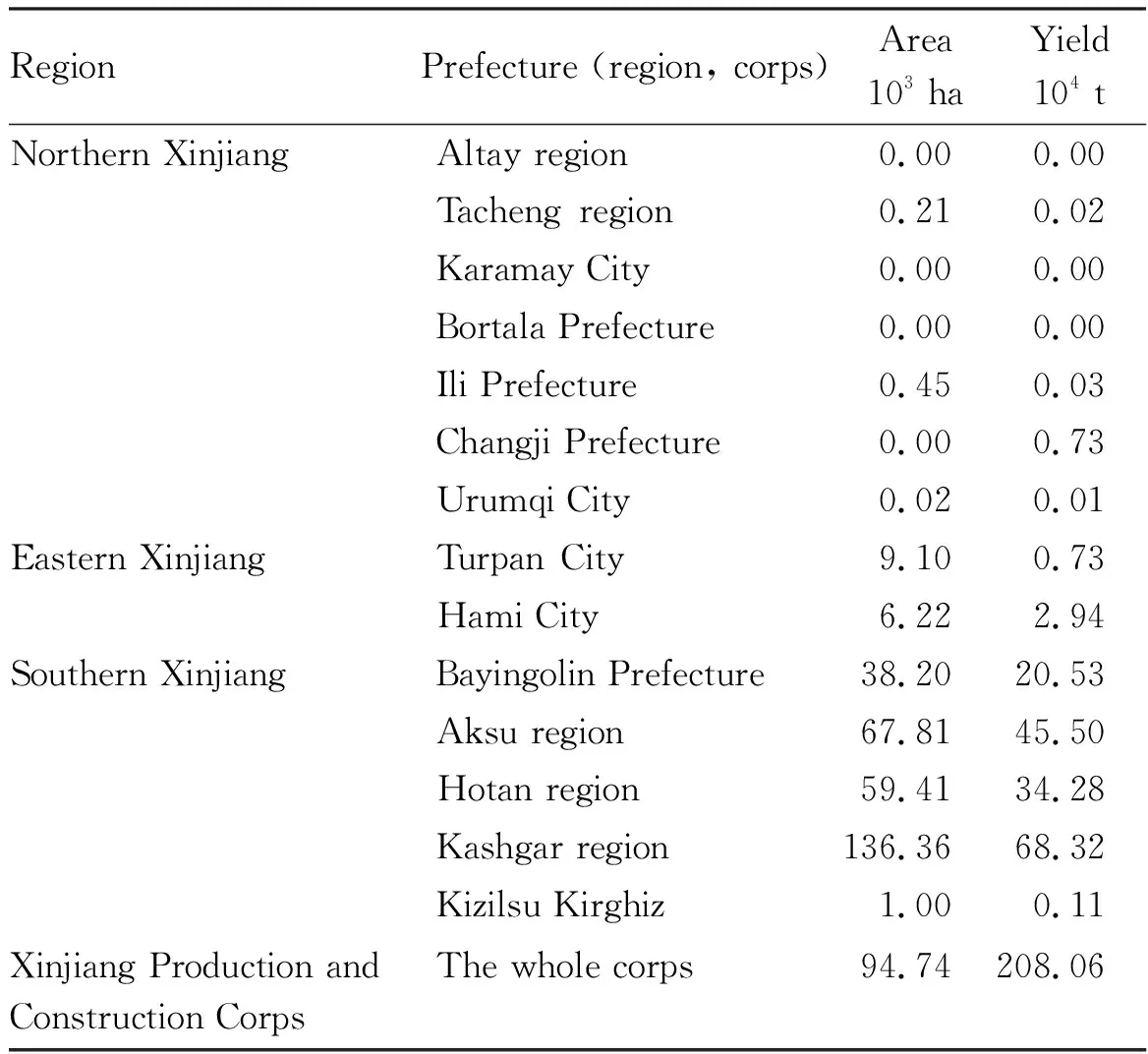
Table 1 Jujube planting area and yield of Xinjiang
Xinjiang jujube yield reached 3.812 4 million t (Table 1), and Xinjiang produced 1.731 8 million t, accounting for 45.43%. Among them, the yield of the seven cities and prefectures in northern Xinjiang was only 7 900 t, accounting for 0.21% of the whole autonomous region; the yield of the two cities in eastern Xinjiang was 36 700 t, accounting for 0.96%; the yield of the five prefectures in southern Xinjiang was as high as 1.687 4 million t, accounting for 44.26%; the yield of Xinjiang Production and Construction Corps was 2.080 6 million t, accounting for 54.57% of the whole autonomous region. In Xinjiang (Table 1), the main production areas of jujube are Kashgar region, Aksu region, Hotan region and Bayingolin Prefecture, with the yield of 683 200, 455 000, 342 800 and 205 300 t, accounting for 17.92%, 11.93%, 8.99% and 5.39% of the whole autonomous region, respectively.
In Xinjiang Production and Construction Corps (Table 2), the main producing areas of jujube are 1stDivision/Alaer City, 3rdDivision /Tumshuk City, 14thDivision/Kunyu City, and 2ndDivision/Tiemenguan City in southern Xinjiang, and 13thDivision/Xinxing City in eastern Xinjiang, with the yield of 1.059 500 million t, 482 700 t, 273 200 t, 222 000 t and 40 700 t, separately accounting for 27.79%, 12.66%, 7.17%, 5.82% and 1.07% of the whole autonomous region.
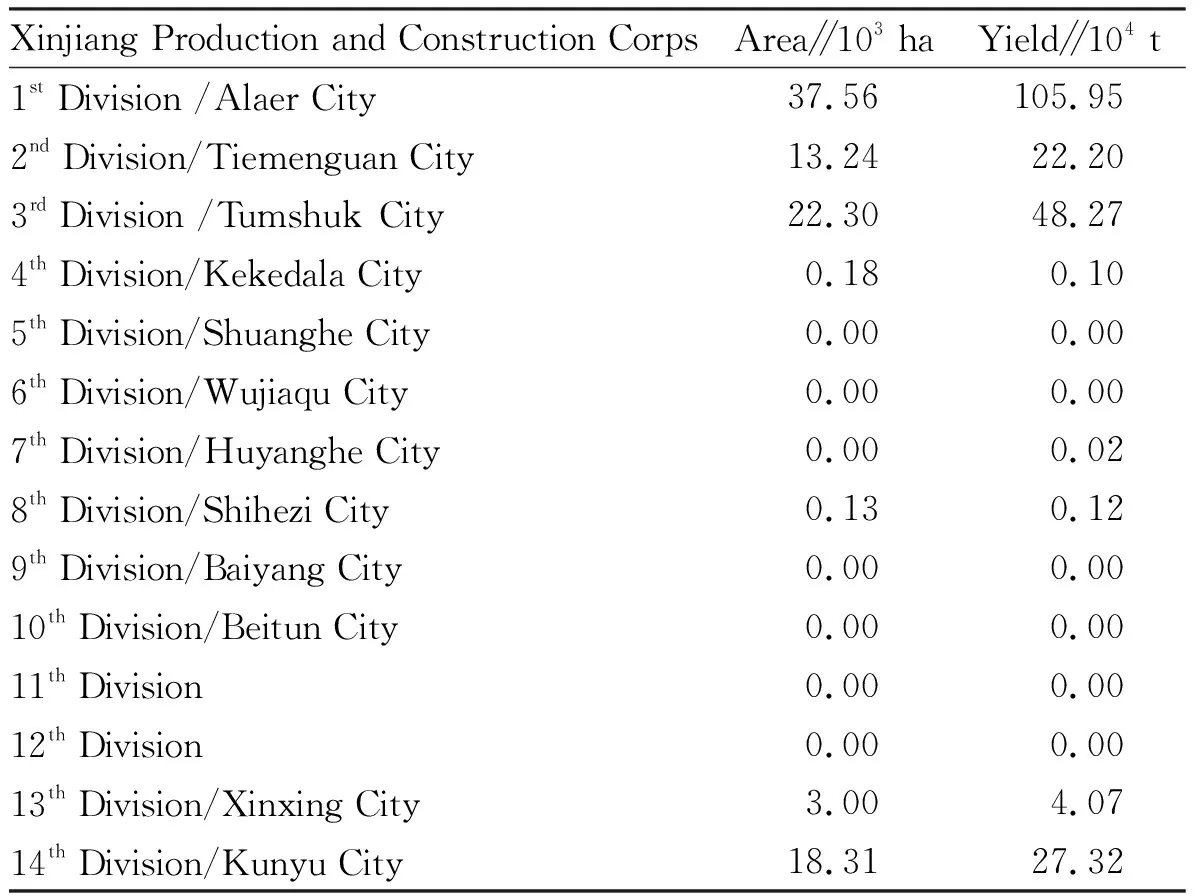
Table 2 Jujube planting area and yield of Xinjiang Production and Construction Corps
2.2 Advantageous counties of characteristic agricultural products (divisions of the corps)TheRegionalLayoutPlanforSpecialAgriculturalProducts(2013-2020) formulated by the former Ministry of Agriculture determined southern Xinjiang, Jiluyu (Hebei-Shandong-Henan) Plain, Loess Plateau, Gansu Minqin, Northwest Liaoning, Southern Fujian and Hainan as the seven characteristic jujube dominant areas in the country. Among the 82 counties (divisions of the corps) with advantageous characteristic jujube in the country, Xinjiang has 28. Among them, there are Turpan City Toksun County, Yizhou District of Hami City, 13thDivision of Xinjiang Production and Construction Corps in eastern Xinjiang; in southern Xinjiang, there are Ruoqiang County and Jimo County in Bayingolin Prefecture, Aksu County, Kuqa City, Wensu County, Shaya County, Xinhe County, Awat County, Hotan County, Pishan County, Qira County, Yutian County, Minfeng County in Aksu region, Shufu County, Shule County, Zepu County, Makit County, Yuephu County, and Payzawat County, and Bachu County in Kashgar Region, 1st, 2nd, 3rdDivision, Regiment 224 of 14thDivision, and Pishan County Farm in Xinjiang Production and Construction Corps.
2.3 "One village, one product" demonstration villages and townsAmong the "one village, one product" demonstration villages and towns in Xinjiang, there are 16 whose leading products are jujubes (Table 3), including 7 in Xinjiang and 9 in Xinjiang Production and Construction Corps.

Table 3 National "one village, one product" demonstration villages and towns for jujubes in southern Xinjiang
2.4 Advantageous areas of characteristic agricultural products and advantageous characteristic industrial clustersAmong the 308 national advantageous areas of characteristic agricultural products, there are the 1stDivision Alaer jujube, Xinjiang Production and Construction Corps Alaer City, and Ruoqiang jujube in Xinjiang Ruoqiang County. In the list of 140 national advantageous and characteristic industrial clusters, there is jujube industrial cluster in Xinjiang Production and Construction Corps. This industrial cluster mainly covers 1stDivision Alaer City, 2ndDivision Tiemenguan City, 3rdDivision Tumshuk City, and 14thDivision Kunyu City of Xinjiang Production and Construction Corps in southern Xinjiang.
2.5 Regional improved variety breeding base and germplasm resource bank (nursery)There is still no national-level improved variety breeding base for jujubes in Xinjiang. Among the 72 national crop germplasm resource banks (nurseries), Xinjiang has the National Xinjiang Unique Fruit Germplasm Resource Nursery (Luntai), the National Central Asian Characteristic Crop Germplasm Resources Medium-term Bank (Urumqi), and the professional germplasm resource bank in other places includes the National Jujube Grape Germplasm Resource Nursery (Taigu).
2.6 Foreign trade transformation and upgrading bases and exportsThere are only three national foreign trade transformation and upgrading bases related to the grape industry in northern Xinjiang:8thDivision Shihezi City National Foreign Trade Transformation and Upgrading Base (Agricultural Products) in Xinjiang Production and Construction Corps, 10thDivision Beituni City National Foreign Trade Transformation and Upgrading Base (Agricultural Products) in Xinjiang Production and Construction Corps, and National Foreign Trade Transformation and Upgrading Base (Canned Fruits and Vegetables) in Urumqi City, Xinjiang Autonomous Region.
The jujube export of Xinjiang is not large, and for many years it has been outside the top ten provinces in China’s jujube export volume. According to Chinese customs data, Xinjiang exported only 310.27 t in 2020 and 1 143.886 t in the first half of 2022 of jujubes, with an amount of 2.599 1 million US dollars, and the main export destinations are China Taiwan, the United Arab Emirates, South Korea, Japan, Yemen, Canada, Vietnam, the Netherlands, Germany and the United States.
3 Intellectual property resources of Xinjiang jujube
Intellectual property resources related to jujubes[9-10]mainly include patents, new plant varieties, geographical indications, trademarks, biological genetic resources, traditional knowledge,etc.
3.1 Traditional knowledgeXinjiang jujube industry is rich in traditional knowledge, mainly including traditional planting techniques, important agricultural cultural heritage (unique land use systems and agricultural landscapes, ancient jujube orchards,etc.), traditional processing techniques, related traditional food production techniques, knowledge of traditional medicine (especially traditional Chinese medicine, Uygur medicine, Kazakh medicine) for jujube medicine (traditional pharmacology, prescriptions, formulations, treatment methods,etc.), traditional names of famous traditional jujube and its traditional products, which belong to important agricultural culture content in the main production area of jujube. Among them, relevant Chinese important agricultural cultural heritages include Turpan Karez agricultural system. Xinjiang has no relevant national intangible cultural heritage, and the autonomous region-level intangible cultural heritage only has melon and fruit storage skills. Traditional names of famous jujube products include Hami jujube, Aksu jujube, and Totan jujube.
3.2 Biogenetic resourcesXinjiang is one of the main production areas of jujube in China, with a long history of cultivation, rich in biological genetic resources[11], has as many as 100 varieties[12], including Hami jujube, Qianghui 1, Qianghui 2, Qianghui 3, Junzao jujube, Huizao jujube, long jujube, Huping jujube, Aksu jujube, Ruoqiang jujube, Kashgar jujube, Zanxin jujube, round crisp jujube, Xinjiang small round jujube, Xinjiang long round jujube, Gingil jujube, Zhanhua winter jujube, Jinsi small jujube, Jinxin jujube, Liuyuexian jujube, Qiyuexian jujube, Jiancui jujube, Xinzhenghong 2, Huizaoxin 1, Jinchang 1, and Jincuimi jujube. Most of the varieties are introduced from traditional jujube areas in the mainland such as Hebei, Shandong, Shanxi, Shaanxi and Henan, and there are few varieties of origin, except for Hami jujube, which has a certain commerciality and cultivation scale, other varieties are mostly sporadic cultivation. In addition, Xinjiang has selected and bred excellent new varieties of jujube such as Qianghui 1, Qianghui 2, Qianghui 3, and Panzao jujube.
3.3 New varieties of forest grass plantsIn China, there are two systems for the protection of new plant variety rights:new varieties of agricultural plants under the Ministry of Agriculture and Rural Affairs; new varieties of forest and grass plants under the State Forestry and Grassland Administration (SFGA). On February 2, 2000 and January 22, 2013, the SFGA promulgated the second and fifth batches of theListofNewPlantVarietiesProtectionofthePeople’sRepublicofChina(ForestandGrassPart), includingZizyphusjujubaMill. andZiziphusMill., but neither were incorporated into theProtectionListofAgriculturalPlantVarietiesofthePeople’sRepublicofChina. So far, SFGA has authorized 41 new varieties of forest and grass plants in the genusZiziphusMill., but its variety rights holders have not involved Xinjiang. Among the 51 new varieties of forest and grass plants that have been authorized, only one new variety in Xinjiang has been involved by the variety rights holder:Panzao jujube, and its variety rights are the Xinjiang Uygur Autonomous Region Jujube Association and Shi Junxian. The three new varieties of jujube selected and bred in 2015, Qianghui 1, Qianghui 2, and Qianghui 3 did not apply for the right to new plant varieties.
3.4 PatentsThe Xinjiang jujube obtained national patents relatively late, starting in 1992, and has obtained a total of 1 978 national patents so far (Fig.1). Among them, there are 1 194 invention patents, accounting for 60.36%, 613 new utility patents, accounting for 30.99%, and 171 industrial design patents, accounting for 8.65%. The top ten applicants (patentees) with the number of patents are:Tarim University (253 patents), Shihezi University (85 patents), Xinjiang Academy of Agricultural and Reclamation Sciences (67 patents), Xinjiang Agricultural University (57 patents), An Xinhui (Aksu City, 26 patents), Institute of Agricultural Mechanization, Xinjiang Academy of Agricultural Sciences (24 patents), Agricultural Products Storage and Processing Research Institute of Xinjiang Academy of Agricultural Sciences (22 patents), Xinjiang University (17 patents), Xinjiang Uygur Autonomous Region Product Quality Supervision and Inspection Institute (15 patents), and Ding Huiyi (Aksu City, 12 patents). These national industrial design patents generally belong to class 9 of the industrial design Locarno Classification (LOC), namely, industrial design used for grape packaging and containers, belonging to the marking class intellectual property rights.
Xinjiang jujubes have obtained 243 national invention patents and 259 national new utility patents in the Planting Industry International Patent Classification (IPC) A01; obtained 6 national invention patents and 0 national utility patents in the breeding field IPC A01H; obtained 320 national invention patents and 117 national utility patents in food field IPC A21 and A23; and obtained 192 national invention patents and 6 national utility patent in medicine and health field IPC A61.

Fig.1 Number of national patents obtained in Xinjiang jujube field during 1990-2022
3.5 Geographical indications (GI)In accordance withEU-ChinaAgreementonCooperationonandProtectionofGeographicalIndications, 275 Chinese geographical indication products will be protected in the EU, including Qira jujube.
China’s geographical indication protection system is still not perfect. At present, there are three systems:(i) geographical indication products of the China National Intellectual Property Administration; (ii) geographical indication trademarks of the Trademark Office of the China National Intellectual Property Administration; (iii) geographical indications of agricultural products of the Ministry of Agriculture and Rural Affairs.
3.5.1Geographical indication products. There are 5 kinds of geographical indication products in Xinjiang jujube industry (Table 4). Northern Xinjiang has no geographical indication products, eastern Xinjiang has Hami jujube, and southern Xinjiang has Ruoqiang jujube, Qiemo jujube, Aksu jujube, and Hotan jujube.
3.5.2GI trademarks. Xinjiang grape industry has 12 geographical indication trademarks (Table 5). Northern Xinjiang has no geographical indication trademarks of jujube. In eastern Xinjiang, there are Hami jujube, and in southern Xinjiang, there are Ruoqiang jujube (registration No.:3590206), Ruoqiang jujube (3590207), and Qiemo jujube, Aksu jujube (registration No.:5015105), Aksu jujube (5098712), Hotan jade jujube (registration No.:7711765), Hotan jade jujube (7871448), Kashgar jujube, Makati jujube, Zepu jujube, Tumshuk winter jujube. As shown in Table 6, the trademark in Class 29 of the International Classification (IC) is dry jujubes, and the trademark in Class 31 is fresh jujubes. Only Ruoqiang jujube, Aksu jujube, and Hotain jade jujube have registered both the geographical indication trademark of dry jujubes and the geographical indication trademark of fresh jujubes. Moreover, jujube, Kashgar jujube, Makati jujube and Zepu jujube only registered the geographical indication trademark of dry jujubes, while Hami jujube and Tumshuk winter jujube only registered the geographical indication trademark of fresh jujubes.
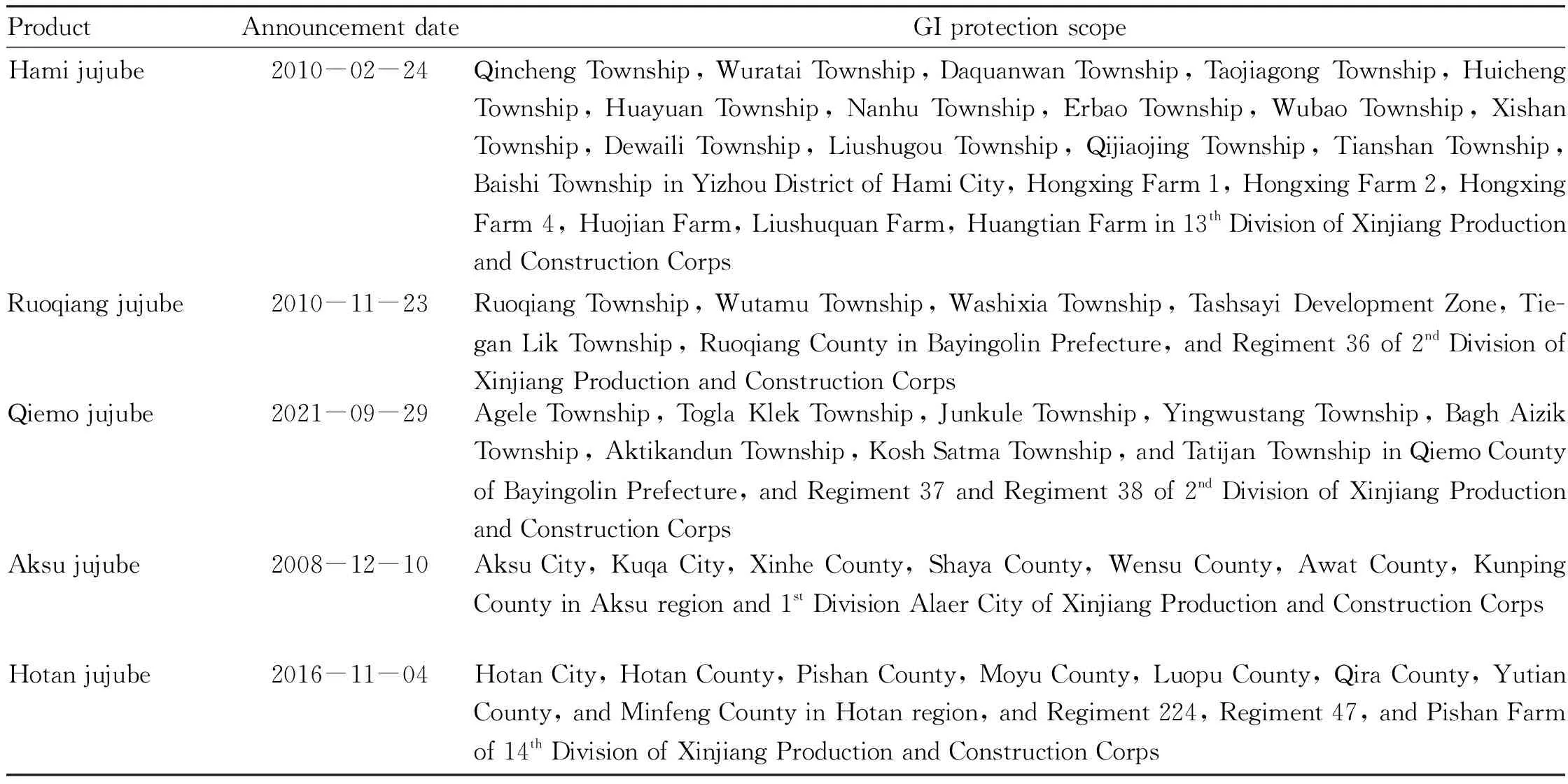
Table 4 GI products related to Xinjiang jujubes
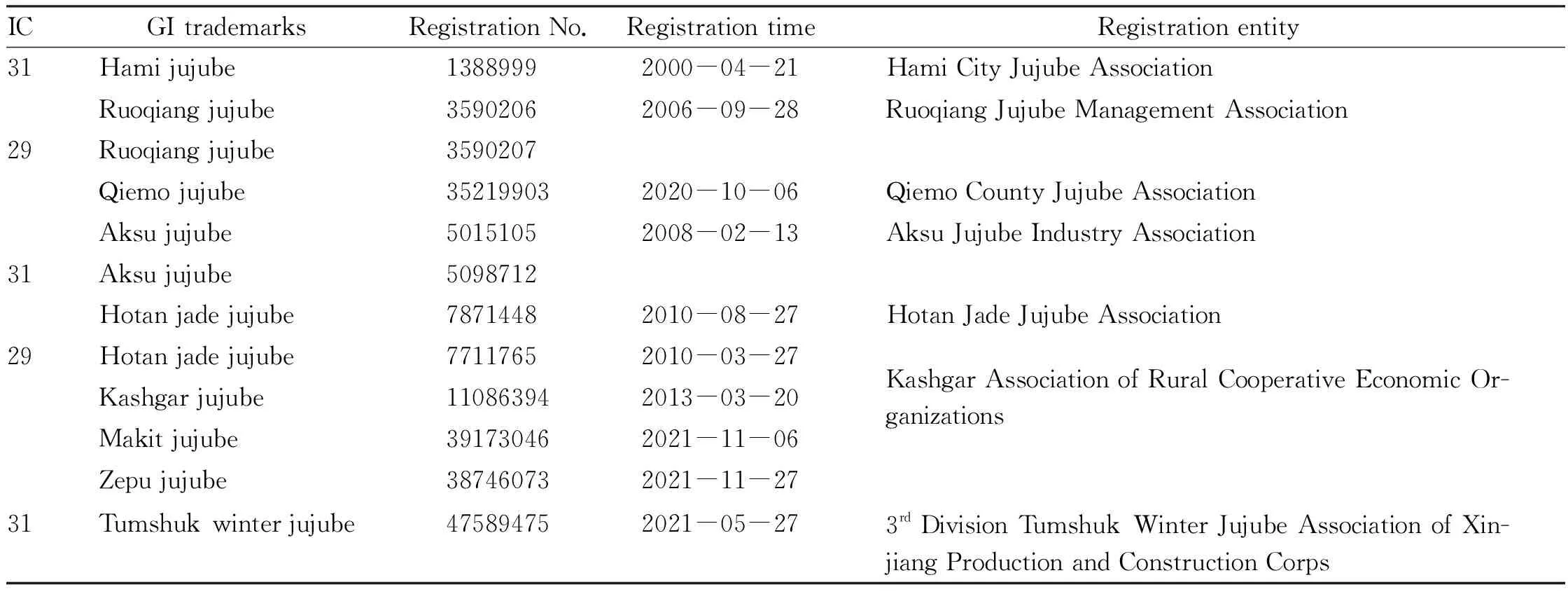
Table 5 Geographical indication trademarks related to Xinjiang jujubes
3.5.3Geographical indications of agricultural products. Xinjiang jujubes have 8 geographical indications of agricultural products (Table 6). Specifically, northern Xinjiang has no geographical indications of agricultural products. There are Liushuquan jujube and Toxun jujube in the eastern Xinjiang, and Qira jujube, Hotan imperial jujube, Minfeng jujube, Hotan jade jujube, Makit jujube, Xinjiang Production and Construction Corps Regiment 48 jujube in southern Xinjiang.
3.6 TrademarksThere are four basic types of trademarks:ordinary trademarks; collective trademarks; certification trademarks; special signs. There are no collective trademarks or special sign trademarks in the jujube industry in Xinjiang, but there are many ordinary trademarks, and related companies generally register their own private ordinary trademarks for their products. Collective trademarks and certification marks are regional public trademarks. The only collective trademarks related to this industry are the "Xinjiang Jujube Association" and 12 certification marks (all geographical indication trademarks) (Table 6). China’s well-known trademarks related to Xinjiang jujube include:certification trademarks "Hotan Jade Jujube", "Ruoqiang Jujube" and so on. Relevant famous trademarks in Xinjiang include:certification trademarks "Hami Jujube", "Aksu Jujube",etc., and the ordinary trademark "Tianshan" (Aksu Region Tianshan Jujube Industry Co., Ltd.).
4 Main problems in the intellectual property protection and the construction of the new development pattern for Xinjiang jujube
4.1 Insufficient protection of heritage intellectual property rights and inheritance of cultural heritageXinjiang is rich in traditional jujube knowledge, biological genetic resources and cultural heritage resources, but the collection and collation of traditional knowledge is insufficient, there are no closely related important agricultural cultural heritage of China, globally important agricultural cultural heritage, national intangible cultural heritage,etc., and only the storage skills of melons and fruits of intangible cultural heritage at the autonomous region level. The awareness of the protection of jujube biological genetic resources is not strong, and the collection and collation of traditional knowledge, agricultural biological genetic resources and other heritage intellectual property rights, as well as jujube agricultural cultural resources, hinders the inheritance of jujube cultural heritage and the identification and extraction of product cultural connotations.
4.2 Backward construction of regional breeding bases and germplasm resource banks (nurseries)There is no jujube national regional breeding base in Xinjiang. Among the 72 national crop germplasm resource banks (nurseries), Xinjiang Jujube Autonomous Region is related to the National Xinjiang Unique Fruit Germplasm Resource nursery (Luntai) and the National Central Asian Characteristic Crop Germplasm Resources Medium-term Bank (Urumqi), but there is no professional germplasm resource bank (nursery), although there are national jujube grape germplasm resource gardens (Taigu) in other regions.
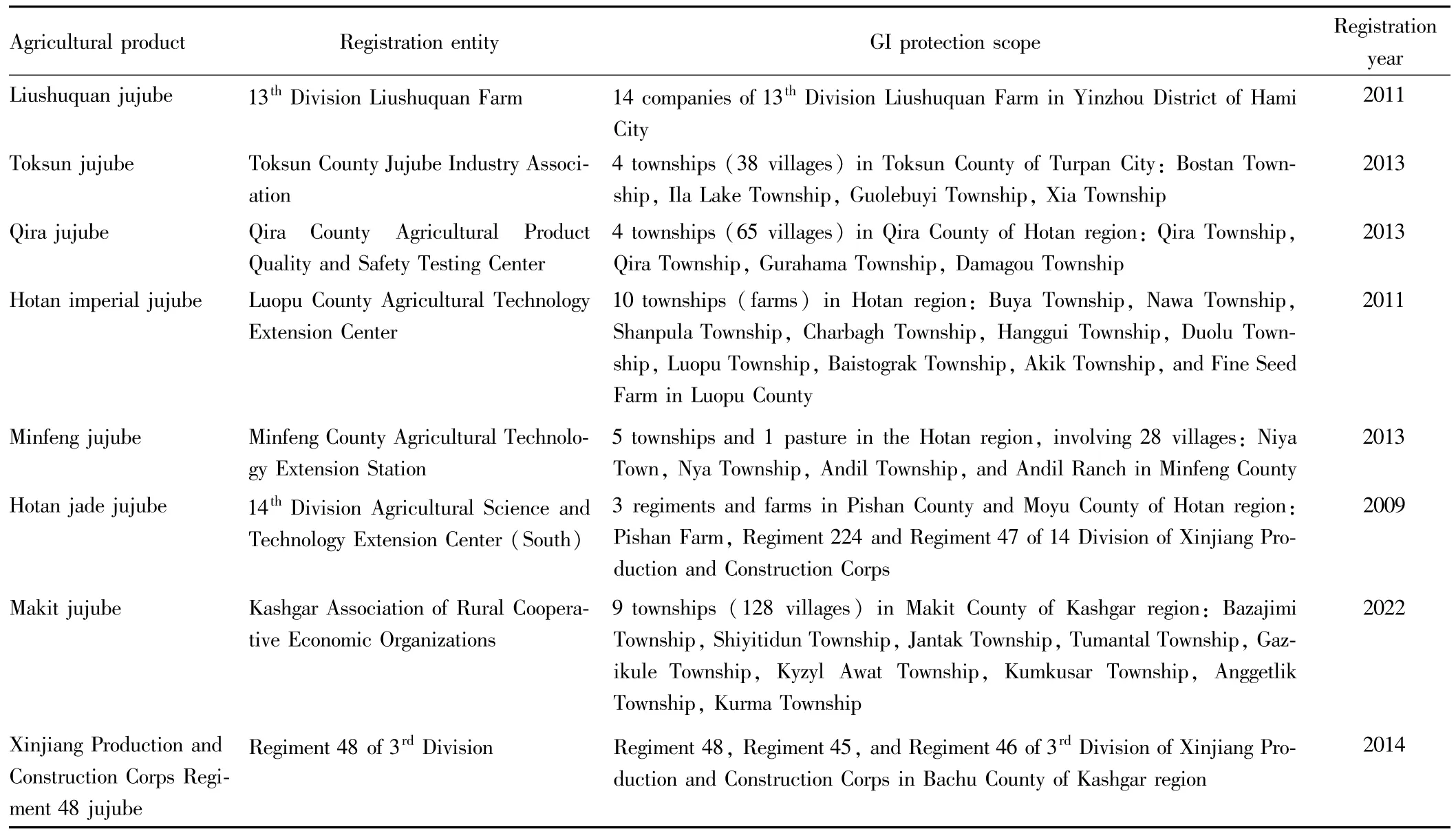
Table 6 Geographical indications of agricultural products of Xinjiang jujubes
4.3 Inadequate protection of regional public trademarks and geographical indicationsThere are many ordinary trademarks in Xinjiang jujube, and the registration of regional public trademarks is ineffective, only 1 collective trademark and 12 certification trademarks have been registered, which hinders the creation of Xinjiang famous trademarks and well-known trademarks in China. In terms of the protection of geographical indication intellectual property rights, there are only 5 kinds of geographical indication products, 12 geographical indication trademarks, and 8 kinds of geographical indications of agricultural products, which only involve Aksu jube, Qira jujube, Hami jujube, Hotan jujube, Hotan jade jujube, Hotan imperial jujube, Kashgar jujube, Liushuquan jujube, Makit jujube, Minfeng jujube, and Qiemo jujube, Ruoqiang jujube, Tumshuk winter jujube, Toksun jujube, Regiment 48 jujube, Zepu jujube and other 16 kinds of jujube, have not yet implemented geographical indication product protection and geographical indication trademark registration for jujube products (especially traditional jujube food), which cannot meet the needs of regional public brands of jujube industry (especially jujube industry chain).
4.4 Weak creative ability of creative intellectual property rightsXinjiang jujube invention patents, new utility patents, new plant varieties and other creative intellectual property rights are weak in creative ability, there are few related high-value patents, and core technologies need to be improved, especially in key technical links such as molecular breeding, product deep processing, and biomedical high-tech.
4.5 Two markets and two resources needing to be further developedThe overseas patents, new plant varieties and other intellectual property rights of Xinjiang jujube are few, and Qira jujube is only the one of the 275 Chinese geographical indication products that will be protected in the EU. The construction of the core area of the Silk Road Economic Belt is mainly focused on "one port", "two zones", "five centers" and "port economic belt", but jujube and other characteristic advantageous industries have not received due attention. The main production area of jujube in Xinjiang has not built a jujube professional national foreign trade transformation and upgrading base, and its jujube overseas market is still very limited.
4.6 The thinking of "three new developments" and the strategy of building an intellectual property power needing to be further implementedGeneral secretary Xi Jinping’s "Three New Developments" thinking (grasping the new development stage, implementing the new development concept, and building a new development pattern), the spirit of the important speech made by Xi Jinping during his inspection tour in Xinjiang in 2022, strategy of building an intellectual property power, the Party’s strategy for governing Xinjiang in the new era, rural revitalization strategy (especially expanding characteristic advantageous industries, cultivating and upgrading agricultural brands, The prosperity and development of rural culture, the effective connection between consolidating and expanding the achievements of poverty alleviation and rural revitalization), and the forging of the meaning of the Chinese national community need to get further rooted in Xinjiang jujube industry.
5 Recommendations for Xinjiang jujube’s intellectual property protection and the construction of new development pattern
5.1 Accurately grasping the new stage of development and inherit and innovate jujube farming cultureIt is necessary to collect and sort out the traditional knowledge, cultural heritage and biological genetic resources of Xinjiang jujube, identify and extract the cultural connotation of jujube and its products, and improve the cultural literacy of regional brands and the cultural added value of products. Besides, it is necessary to accurately grasp the new stage of development, the historical stage of the great rejuvenation of the Chinese nation in which inheritance and innovation go hand in hand, and take traditional knowledge, cultural heritage and biological genetic resources as the source of innovation for jujube industry. In addition, we should carry forward the knowledge and culture of relevant traditional medicine (especially traditional Chinese medicine, Uyghur medicine and Kazakh medicine), inherit the production skills of jujube traditional products, actively declare Chinese and global important agricultural cultural heritage, national and autonomous region level intangible cultural heritage, and inherit and innovate agricultural culture in the field of jujube.
5.2 Building national agricultural germplasm resource banks (nurseries) and create a national regional breeding base for jujubeIt is recommended to collect the germplasm resources of Xinjiang jujube, introduce excellent varieties from abroad and the mainland, and maintain the diversity of jujube biological genetic resources. It is necessary to build relevant national Xinjiang endemic fruit germplasm resource nursery (Luntai), national Central Asian characteristic crop germplasm resource medium-term bank (Urumqi), national jujube grape germplasm resource nursery (Taigu) experience, create a national jujube grape germplasm resource nursery (Hotan), comprehensively build Xinjiang jujube national regional fine seed breeding base, and build Qira County, Aksu City, Ruoqiang County, Toksun County, Yizhou District, the 3rdDivision and 14thDivision of the construction corps and other large counties (divisions) of the jujube seed industry.
5.3 Protecting and using the intellectual property rights of logos to create a regional public brand of the whole industry chain of jujubeXinjiang should collect and sort out the natural and human factors of geographical indications of famous and special jujube and their products, apply for the geographical indication of jujube agricultural products to the Ministry of Agriculture and Rural Affairs, apply for the geographical indication trademark of jujube and its products to the Trademark Office of the China National Intellectual Property Administration, and apply for geographical indication product protection of jujubes and their products to China National Intellectual Property Administration. It is necessary to formulate corresponding national standards for each geographical indication product, geographical indication trademark, and geographical indication of agricultural products. Xinjiang should encourage new agricultural business entities such as large jujube professional households, family farms, farmer cooperatives, agricultural enterprises and ordinary farmers within the scope of geographical indication protection to use the corresponding special indications of geographical indications, and actively register collective trademarks and certification trademarks, and use these two regional public trademarks to compete for famous trademarks in Xinjiang and well-known trademarks in China. Taking geographical indications as the basis, Xinjiang can integrate regional brands of jujube and their products in the main producing areas, improve the protection and application of geographical indications, collective trademarks, certification trademarks, Locarno Classification Class 9 design patents and other trademark intellectual property rights, strengthen brand marketing, and create a regional public brand of the whole industry chain of jujube.
5.4 Strengthening the creation of intellectual property rights related to jujube creation and promoting the innovation-driven development strategyIt is recommended to use the pairing-assistance to Xinjiang project, combined with the local foundation, to create a cross-regional "production, universities, research institutions, utilizations and innovations" five-in-one Xinjiang jujube industry innovation platform. Specifically, Xinjiang can concentrate on the field of breeding (IPC A01H), medicine and health (IPC A61), and the deep processing of jujube products, create high-value invention patents, new utility patents, cultivate new plant varieties, deploy innovation chains along the industrial chain, overcome the key science and technology of jujube development, and promote innovation-driven development strategies.
5.5 Unblocking the whole chain of intellectual property creation, application, protection, management and service, and developing the jujube knowledge economyIn accordance withOutlineforBuildinganIntellectualPropertyPower(2021-2035),14thFive-YearPlanfortheProtectionandUseofIntellectualPropertyRights,OpinionsonAcceleratingtheHigh-qualityDevelopmentoftheIntellectualPropertyServiceIndustry, it is required to strengthen intellectual property education in Xinjiang jujube industry, raise awareness of intellectual property protection, develop intellectual property service industry, improve the level of creation, application, protection, management and service of intellectual property, open up the whole chain of intellectual property rights, and develop jujube knowledge economy.
5.6 Fully implementing the new development concept and promoting the high-quality development of jujubeIt is recommended to implement the new development concept, adhere to innovative development, coordinated development, green development, open development and shared development, strengthen the "agricultural chip" and high-tech development of the jujube industry, promote comprehensive land consolidation, build high-standard jujube fields, implement the military-civilian integration development strategy, promote the coordinated development of regions, products, military and civilians, strengthen the certification of pollution-free agricultural products, green food, and organic agricultural products, develop green products, strengthen the opening up of industries, and strengthen the sharing between local major producing areas and the construction corps and local and domestic major producing provinces. Besides, Xinjiang should implement the strategy of quality rejuvenation of agriculture, improve the management of the production process of the jujube industry, actively participate in the formulation of national standards for related products, promote the standardization of the whole jujube industry chain, improve the degree of standardization and quality and safety, and promote the high-quality development of jujube.
5.7 Expanding the industries with jujube characteristics and promoting the construction of the core area of the Silk Road Economic BeltIt is recommended to use the "one port" (Urumqi International Dry Port Zone), "two zones" (Kashgar and Khorgas economic development zones), "five centers" (transportation hub center, commercial logistics center, medical service center, cultural science and education center, and regional financial center), "port economic belt" (19 open ports along the border) to prosper the rural jujube industry, consolidate and expand the achievements of poverty alleviation and effectively connect with rural revitalization, especially the four prefectures (Hotan region, Aksu region, Kashgar region, and Kizilsu Kirghiz region) in southern Xinjiang, which used to be a severely impoverished area in the past. Besides, it is recommended to build a national "one product for one village" demonstration village and town, build the 1stDivision of Xinjiang Production and Construction Corps Alaer jujube in Alaer City, Ruoqiang County Ruoqiang County in Xinjiang Ruoqiang jujube Chinese Characteristic Agricultural Products Advantage Zone and Xinjiang Production and Construction Corps jujube industry cluster, and expand jujube characteristic advantageous industries and promote the construction of the core area of the Silk Road Economic Belt.
5.8 Coordinating the two markets and two resources, and accelerating the construction of dual-cycle new development model for jujube industryXinjiang should face the domestic market and international market, take advantage of the three relevant national foreign trade transformation and upgrading bases in northern Xinjiang to strive to create jujube foreign trade transformation and upgrading bases in eastern and southern Xinjiang, increase exports, expand jujube domestic demand, and establish high-quality supply chains both at home and abroad. In addition, it is recommended to make full use of domestic and foreign resources, develop the whole industry chain of jujube, and accelerate the construction of a new development pattern with domestic circulation as the main body and domestic and international dual circulation promoting each other.
杂志排行
Asian Agricultural Research的其它文章
- Analysis of Application Status and Recommendations for Shade-Tolerant Lawns and Ground Cover Plants in the West Lake Scenic Area
- Cloing and Bioinformatics Analysis of ndk Gene from Vibrio alginolyticus
- Design of Diversified Intelligent Control System for Energy-saving Optimization of Solar Greenhouse in North China
- Determination of Lead in Lime-preserved Egg by Microwave Digestion and Flame Atomic Absorption Spectroscopy
- Analysis of Land Use Change and Driving Factors in Mojiang County Based on PLUS Model
- Current Situation, Reasons and Suggestions of Income and Consumption of Rural Residents
